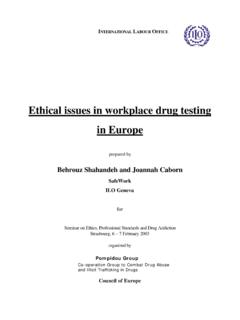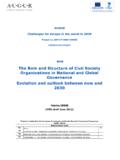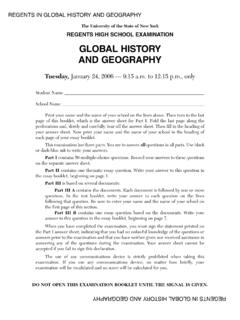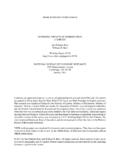Transcription of INDEX TERM II CHAPTER NAME PAGE NO HISTORY
1 INDEX . TERM II. CHAPTER name PAGE NO. HISTORY . 1. THE RISE OF NATIONALISM IN europe 83-86. 2. NATIONALIST MOVEMENT IN INDO-CHINA 87-89. 3. NATIONALISM IN INDIA 90-93. MAP 94. GEOGRAPHY. 5. MINERALS AND ENERGY RESOURCES 95-97. 6. MANUFACTURING INDUSTRIES 98-100. 7. LIFE LINES OF NATIONAL ECONOMY 101-102. MAPS 103-107. POLITICAL SCIENCE. 5. POPULAR STRUGGLES AND MOVEMENTS 108-111. 6. POLITICAL PARTIES 112-115. 7. OUTCOMES OF DEMOCRACY 116-118. 8. CHALLENGES TO DEMOCRACY 119-120. ECONOMICS. 3. MONEY AND CREDIT 121-124.
2 4. GLOBALISATION AND THE INDIAN ECONOMY 125-128. 5. CONSUMER RIGHTS 129-132. DESIGN OF QUESTION PAPER 133. BLUE PRINT 134. QUESTION PAPER 135-139. SCORING KEY 140-143. 82. TERM II. HISTORY . CLASS X. CHAPTER -1. THE RISE OF NATIONALISM IN europe . Unification of Italy and French Revolution and Germany the idea of a nation Nationalism in europe Visualizing the nation Imperialism and Nationalism Key Concepts of the lesson- In 1848, Frederic Sorrieu a French artist prepared a series of four prints visualizing his dream of a world made up of democratic and social Republic.
3 The first print shows the people of europe and America-men and women of all ages offering homage to Statue of Liberty. 1. The French Revolution and the idea of Nation- Growth of nationalism in France. Introduction of various measures and practices created sense of collective identity among the people of France Change of monarchy and establishment of republic, creation of new assembly. Rise of Napoleon and his reforms. Revolutionaries help other people of europe to become nation. 2. The making of Nationalism in europe .
4 Germany, Italy and Switzerland were divided into Kingdom, duchies and cantones these divisions were having their autonomous rulers. Uses of different languages. Rise of middle class. Industrialization in England, emergence of a working class and liberalism. New conservation after 1815 and preservation of traditional institution. After the defeat of Napoleon, the European government follows the spirit of conservatism. Conservative regimes were autocratic Revolutionaries at that time fought for liberty and freedom.
5 Mazzini, s young Italy and Young europe . 83. 3. The age of Revolution (1830-48). Liberalism and Nationalism. Greek war of independence against Ottoman Empire and treaty of Constantinople. Emphasis in vernacular. Hunger hardship and popular revolt. Demand for constitutionalism and national unification. Rights for women Results- Frankfurt Parliament (May 1848). 4. Unification of Germany and Italy. Changing concept of Nationalism after 1848, emergence of new nation. Germany and role of Bismarck and his policy unification of Germany.
6 Unification of Italy. Role of Mazzini Garibaldi and Victor Emanuel II Separate case and condition of Britain-Glorious revolution of 1688, Act of union of 1707. 5. Visualizing the Nation- Representing Nationalism and ideas through female allegory such a Marianne (France) and Germania (German Nation). 6. Nationalism and Imperialism- Last quarter of the 19th century nationalism became a narrow creed with limited ends, Intolerance Balkan became the sense of big power rivalry Nationalism, aligned with imperialism cause of World War I.
7 Idea of a Nationalism was now same everywhere. But concept of National State was accepted universally. AT A GLANCE. Conservatism is a political philosophy that stressed the importance of tradition, and professed gradual development to quick change. Giuseppe Mazzini was an Italian revolutionary and member of Secret society? Ottovon Bismarck was the chief minister of Prussia and was the architect of the unification of Germany. Romanticism was a cultural movement which sought to develop particular form of nationalist sentiments.
8 Nation state is the one in which the majority of its citizens came to develop a sense of common identity and shared HISTORY or descent. The Treaty of Vienna was hosted by the Austrian Chancellor Duke Metternich in 1815. Nationalist feelings were kept alive in Poland through music and language. Kaiser William1 was the emperor of united Germany Liberalism stands for freedom of the individual and equality of all before law. SHORT ANSWER TYPE QUESTIONS (3 MARKS). 1. Briefly explain Greek war of Independence. Greek under Ottoman Empire Growth of Nationalism sparked the struggle.
9 Got support from Western Europeans Poets and artists lauded Greece Finally with Treaty of Constantinople Greece became independent. 2. 1830's is called the year of Economic hardship. Increase in population in europe , Unemployment among people. Small producer in town faced competition. Rise in food prices led to poverty. 84. 3. What were the measures taken by French revolutionaries to forge a sense of collective identity? Through the ideas of la patrie and le citiyon New tricolor flag Composition of new system of hymns and commemoration of martyrs Formulating uniform laws for all citizens.
10 4. Explain the consequences of the Vienna congress The Bourbon dynasty was restored in France, A number of states were set up on the boundaries of France. Prussia was given important new territories, Austria got control of northern Italy, Russia was given part of Poland. 5. Why the 1830s were the years of great economic hardship in europe . Increase in population, Unemployment, migration, price rise, stiff competition in the market, Bad condition of peasants. 6. How was the HISTORY of nationalism in Britain unlike the rest of europe ?








